

[
] 105
continuous professional dialogue and reflection and to development
of professional learning communities within and across schools to
ensure that innovations are rigorous, evidence-based, grounded in
the authentic pedagogical problematics of classrooms and schools,
and broadly supported by staff.
Systemic institutional alignment and tightly
coupled governance
One of the most distinctive features of the educational system in
Singapore, and a key to its strength, coherence and capacity for
systemic innovation, is the tightly coupled institutional nature of the
system. This is reflected in three key institutional arrangements. The
first is the very close coupling at the pedagogical level of the curricu-
lum, assessment and classroom instruction, principally secured and
maintained by the national high-stakes assessment system at the end
of primary school (year 6), the end of secondary school (year 10)
and the end of post-secondary education (year 12). In Singapore, as
in other similar systems, teachers ‘teach to the test’. In Singapore,
however, the ‘test’ is also strongly aligned as a matter of policy to
the national curriculum, resulting in an unusually high degree of
pedagogical alignment across the system.
Secondly, there is strong alignment between pedagogical policy,
practice and research, secured by the relatively centralized nature
of policy making and programme implementation in Singapore
with respect to curriculum, assessment and instruction, and by the
extremely generous support by the Ministry of a national education
research agenda at NIE, which is both institutionally autonomous
from the government and also highly responsive to national educa-
tion policy priorities.
Thirdly, with respect to system policy and teacher training
and professional development, there is an unusually high degree
of institutional articulation (commonly known as the tripartite
relationship) between the Ministry, NIE and schools, secured
by specific governance arrangements between NIE and the
Ministry, for example, and by funding and report-
ing accountabilities.
A culture of continuous innovation
and improvement
Finally, in keeping with the Singaporean govern-
ment’s wider aims, the educational system in
Singapore at all levels is strongly committed to
continual innovation and improvement. Supported
by a broad national agenda and policy settings (inno-
vation and enterprise), Ministry officials, NIE staff
and school leaders constantly monitor changes in the
local and international educational landscape, travel
extensively to visit schools and systems in other top
performing countries, review and revise curriculum
and assessment frameworks on a regular basis, fund
a national research agenda into classroom peda-
gogy and how to improve it, support action research
initiatives at the classroom and school levels, and
encourage students to be self-confident, agentic,
enterprising and, with good reason, optimistic about
Singapore’s future.
In general terms, it is mistaken to assume that
systems can simply import successful innovations from
other systems – educational systems, and the actors
within them, are embedded in and shaped by a range
of institutional and cultural imperatives and norms.
Singapore works the way it does – and as well as it
does – because of the way it has (for complex histori-
cal, cultural and political reasons) institutionalized a
specific pattern of pedagogical practice, alignment and
governance. Essentially, Singapore has figured out how
to design, manage, sustain and continually improve a
successful system of education. Consequently, we think
The purpose-built NIE campus spreads across 16 hectares with six blocks serving a full-time enrolment of close to 7,000 student-teachers
Image: NIE, Singapore
















